The Spatiotemporal Variability of Soil Available Phosphorus and Potassium in Karst Region: The Crucial Role of Socio-Geographical Factors
Abstract
1. Introduction
2. Materials and Methods
2.1. Study Area
2.2. Soil Sampling and Chemical Analysis
2.3. Environmental Variables
2.4. Classical Statistics
2.5. Spatiotemporal Analysis of AVP and AVK
2.6. RF Modeling and Accuracy Comparison
2.7. Variable Importance and Partial Dependence Plot Analysis
3. Results
3.1. Descriptive Statistics
3.2. Spatio-Temporal Variability of Soil Properties
3.3. Model Performance
3.4. Relative Importance of Covariates and PDP Analysis
3.5. Nonlinear Threshold and Interaction Effects of Key Factors
4. Discussion
4.1. Temporal Changes of AVP and AVK from 2012 to 2021
4.2. Effect of Socio-Geographical Factors on AVP Changes and AVK Changes
4.3. Influence of Other Environmental Variables
4.4. Interaction Effects of the Three Most Important Environmental Variables
4.5. Implications and Limitations
5. Conclusions
Supplementary Materials
Author Contributions
Funding
Data Availability Statement
Acknowledgments
Conflicts of Interest
References
- Li, T.; Liang, J.; Chen, X.; Wang, H.; Zhang, S.; Pu, Y.; Xu, X.; Li, H.; Xu, J.; Wu, X.; et al. The Interacting Roles and Relative Importance of Climate, Topography, Soil Properties and Mineralogical Composition on Soil Potassium Variations at a National Scale in China. CATENA 2021, 196, 104875. [Google Scholar] [CrossRef]
- He, X.; Augusto, L.; Goll, D.S.; Ringeval, B.; Wang, Y.; Helfenstein, J.; Huang, Y.; Yu, K.; Wang, Z.; Yang, Y.; et al. Global Patterns and Drivers of Soil Total Phosphorus Concentration. Earth Syst. Sci. Data Discuss. 2021, 13, 5831–5846. [Google Scholar] [CrossRef]
- Blanchet, G.; Libohova, Z.; Joost, S.; Rossier, N.; Schneider, A.; Jeangros, B.; Sinaj, S. Spatial Variability of Potassium in Agricultural Soils of the Canton of Fribourg, Switzerland. Geoderma 2017, 290, 107–121. [Google Scholar] [CrossRef]
- Turner, M.D.; Hiernaux, P. The Effects of Management History and Landscape Position on Inter-Field Variation in Soil Fertility and Millet Yields in Southwestern Niger. Agric. Ecosyst. Environ. 2015, 211, 73–83. [Google Scholar] [CrossRef]
- Song, X.; Alewell, C.; Borrelli, P.; Panagos, P.; Huang, Y.; Wang, Y.; Wu, H.; Yang, F.; Yang, S.; Sui, Y. Pervasive Soil Phosphorus Losses in Terrestrial Ecosystems in China. Glob. Chang. Biol. 2024, 30, e17108. [Google Scholar]
- Ziadi, N.; Whalen, J.K.; Messiga, A.J.; Morel, C. Chapter Two—Assessment and Modeling of Soil Available Phosphorus in Sustainable Cropping Systems. Adv. Agron. 2013, 122, 85–126. [Google Scholar]
- Roger, A.; Libohova, Z.; Rossier, N.; Joost, S.; Maltas, A.; Frossard, E.; Sinaj, S. Spatial Variability of Soil Phosphorus in the Fribourg Canton, Switzerland. Geoderma 2014, 217–218, 26–36. [Google Scholar] [CrossRef]
- Liu, J.; Diamond, J. China’s Environment in a Globalizing World. Nature 2005, 435, 1179–1186. [Google Scholar] [CrossRef] [PubMed]
- MacDonald, G.K.; Bennett, E.M.; Potter, P.A.; Ramankutty, N. Agronomic Phosphorus Imbalances across the World’s Croplands. Proc. Natl. Acad. Sci. USA 2011, 108, 3086–3091. [Google Scholar] [CrossRef]
- Chen, W.; Geng, Y.; Hong, J.; Yang, D.; Ma, X. Life Cycle Assessment of Potash Fertilizer Production in China. Resour. Conserv. Recycl. 2018, 138, 238–245. [Google Scholar] [CrossRef]
- Steinfurth, K.; Hirte, J.; Morel, C.; Buczko, U. Conversion Equations between Olsen-P and Other Methods Used to Assess Plant Available Soil Phosphorus in Europe—A Review. Geoderma 2021, 401, 115339. [Google Scholar] [CrossRef]
- Chen, S.; Yan, Z.; Chen, Q. Estimating the Potential to Reduce Potassium Surplus in Intensive Vegetable Fields of China. Nutr. Cycl. Agroecosyst. 2017, 107, 265–277. [Google Scholar] [CrossRef]
- Zhang, W.; Chen, X.; Ma, L.; Deng, Y.; Cao, N.; Xiao, R.; Zhang, F.; Chen, X. Re-Prediction of Phosphate Fertilizer Demand in China Based on Agriculture Green Development. Acta Pedol. Sin. 2023, 60, 1389–1397, (In Chinese with English Abstract). [Google Scholar]
- Zhong, S.; Liu, W.; Ni, C.; Yang, Q.; Ni, J.; Wei, C. Runoff Harvesting Engineering and Its Effects on Soil Nitrogen and Phosphorus Conservation in the Sichuan Hilly Basin of China. Agric. Ecosyst. Environ. 2020, 301, 107022. [Google Scholar] [CrossRef]
- Nimalka Sanjeewani, H.K.; Samarasinghe, D.P.; De Costa, W.A.J.M. Influence of Elevation and the Associated Variation of Climate and Vegetation on Selected Soil Properties of Tropical Rainforests across a Wide Elevational Gradient. CATENA 2024, 237, 107823. [Google Scholar] [CrossRef]
- Glaser, B.; Lehmann, J.; Zech, W. Ameliorating Physical and Chemical Properties of Highly Weathered Soils in the Tropics with Charcoal—A Review. Biol. Fertil. Soils 2002, 35, 219–230. [Google Scholar] [CrossRef]
- Samaké, O.; Smaling, E.M.A.; Kropff, M.J.; Stomph, T.J.; Kodio, A. Effects of Cultivation Practices on Spatial Variation of Soil Fertility and Millet Yields in the Sahel of Mali. Agric. Ecosyst. Environ. 2005, 109, 335–345. [Google Scholar] [CrossRef]
- He, X.; Chu, C.; Yang, Y.; Shu, Z.; Li, B.; Hou, E. Bedrock and Climate Jointly Control the Phosphorus Status of Subtropical Forests along Two Elevational Gradients. CATENA 2021, 206, 105525. [Google Scholar] [CrossRef]
- Liu, X.; Li, S.; Wang, S.; Bian, Z.; Zhou, W.; Wang, C. Effects of Farmland Landscape Pattern on Spatial Distribution of Soil Organic Carbon in Lower Liaohe Plain of Northeastern China. Ecol. Indic. 2022, 145, 109652. [Google Scholar] [CrossRef]
- He, X.; Yang, L.; Li, A.; Zhang, L.; Shen, F.; Cai, Y.; Zhou, C. Soil Organic Carbon Prediction Using Phenological Parameters and Remote Sensing Variables Generated from Sentinel-2 Images. CATENA 2021, 205, 105442. [Google Scholar] [CrossRef]
- Liu, F.; Wang, X.; Chi, Q.; Tian, M. Spatial Variations in Soil Organic Carbon, Nitrogen, Phosphorus Contents and Controlling Factors across the “Three Rivers” Regions of Southwest China. Sci. Total Environ. 2021, 794, 148795. [Google Scholar] [CrossRef] [PubMed]
- Wang, S.; Li, Z.; Li, L.; Xu, Y.; Wu, G.; Liu, Q.; Peng, P.; Li, T. Soil Potassium Balance in the Hilly Region of Central Sichuan, China, Based on Crop Distribution. Sustainability 2023, 15, 15348. [Google Scholar] [CrossRef]
- Wadoux, A.M.-C.; Molnar, C. Beyond Prediction: Methods for Interpreting Complex Models of Soil Variation. Geoderma 2022, 422, 115953. [Google Scholar] [CrossRef]
- Petermann, E.; Meyer, H.; Nussbaum, M.; Bossew, P. Mapping the Geogenic Radon Potential for Germany by Machine Learning. Sci. Total Environ. 2021, 754, 142291. [Google Scholar] [CrossRef] [PubMed]
- Wu, Z.; Chen, Y.; Yang, Z.; Liu, Y.; Zhu, Y.; Tong, Z.; An, R. Spatial Distribution of Lead Concentration in Peri-Urban Soil: Threshold and Interaction Effects of Environmental Variables. Geoderma 2023, 429, 116193. [Google Scholar] [CrossRef]
- Wang, K.; Zhang, C.; Chen, H.; Yue, Y.; Zhang, W.; Zhang, M.; Qi, X.; Fu, Z. Karst Landscapes of China: Patterns, Ecosystem Processes and Services. Landsc. Ecol. 2019, 34, 2743–2763. [Google Scholar] [CrossRef]
- Liu, G.; Deng, L.; Wu, R.; Guo, S.; Du, W.; Yang, M.; Bian, J.; Liu, Y.; Li, B.; Chen, F. Determination of Nitrogen and Phosphorus Fertilisation Rates for Tobacco Based on Economic Response and Nutrient Concentrations in Local Stream Water. Agric. Ecosyst. Environ. 2020, 304, 107136. [Google Scholar] [CrossRef]
- Zhang, W.-C.; Wu, W.; Liu, H.-B. Planting Year-and Climate-Controlled Soil Aggregate Stability and Soil Fertility in the Karst Region of Southwest China. Agronomy 2023, 13, 2962. [Google Scholar] [CrossRef]
- Chen, S.; Arrouays, D.; Leatitia Mulder, V.; Poggio, L.; Minasny, B.; Roudier, P.; Libohova, Z.; Lagacherie, P.; Shi, Z.; Hannam, J.; et al. Digital Mapping of GlobalSoilMap Soil Properties at a Broad Scale: A Review. Geoderma 2022, 409, 115567. [Google Scholar] [CrossRef]
- Institute of Soil Science, Chinese Academy Science (ISSCAS). Soil Physical and Chemical Analysis; Shanghai Science and Technology Press: Shanghai, China, 1978. (In Chinese) [Google Scholar]
- McBratney, A.B.; Mendonça Santos, M.L.; Minasny, B. On Digital Soil Mapping. Geoderma 2003, 117, 3–52. [Google Scholar] [CrossRef]
- Jenny, H. Factors of Soil Formation: A System of Quantitative Pedology; Courier Corporation: North Chelmsford, MA, USA, 1994; ISBN 0486681289. [Google Scholar]
- Ahmadi Mirghaed, F.; Souri, B. Spatial Analysis of Soil Quality through Landscape Patterns in the Shoor River Basin, Southwestern Iran. CATENA 2022, 211, 106028. [Google Scholar] [CrossRef]
- Winzeler, H.E.; Owens, P.R.; Joern, B.C.; Camberato, J.J.; Lee, B.D.; Anderson, D.E.; Smith, D.R. Potassium Fertility and Terrain Attributes in a Fragiudalf Drainage Catena. Soil Sci. Soc. Am. J. 2008, 72, 1311–1320. [Google Scholar] [CrossRef]
- Cheng, Y.; Li, P.; Xu, G.; Li, Z.; Cheng, S.; Gao, H. Spatial Distribution of Soil Total Phosphorus in Yingwugou Watershed of the Dan River, China. CATENA 2016, 136, 175–181. [Google Scholar] [CrossRef]
- Wang, H.J.; Shi, X.Z.; Yu, D.S.; Weindorf, D.C.; Huang, B.; Sun, W.X.; Ritsema, C.J.; Milne, E. Factors Determining Soil Nutrient Distribution in a Small-Scaled Watershed in the Purple Soil Region of Sichuan Province, China. Soil Tillage Res. 2009, 105, 300–306. [Google Scholar] [CrossRef]
- Gorelick, N.; Hancher, M.; Dixon, M.; Ilyushchenko, S.; Thau, D.; Moore, R. Google Earth Engine: Planetary-Scale Geospatial Analysis for Everyone. Remote Sens. Environ. 2017, 202, 18–27. [Google Scholar] [CrossRef]
- NASA; METI. AIST, Japan Spacesystems and US/Japan ASTER Science Team: ASTER Global Digital Elevation Model V003, NASA EOSDIS Land Processes DAAC [Data Set] 2019. Available online: https://lpdaac.usgs.gov/products/astgtmv003/ (accessed on 22 January 2022).
- McGarigal, K.; Cushman, S.A.; Neel, M.C.; Ene, E. Spatial Pattern Analysis Program for Categorical Maps. 2002. Available online: https://fragstats.org/ (accessed on 28 January 2024).
- ESRI. ArcGIS Desktop, Release 10; Environmental Systems Research Institute: Redlands, CA, USA, 2011; Available online: https://www.scirp.org/reference/ReferencesPapers?ReferenceID=1102852 (accessed on 10 June 2024).
- IBM Corp. IBM SPSS Statistics for Windows; Version 22.0; IBM Corp: Armonk, NY, USA, 2013. [Google Scholar]
- Cambardella, C.A.; Moorman, T.B.; Novak, J.M.; Parkin, T.B.; Karlen, D.L.; Turco, R.F.; Konopka, A.E. Field-Scale Variability of Soil Properties in Central Iowa Soils. Soil Sci. Soc. Am. J. 1994, 58, 1501–1511. [Google Scholar] [CrossRef]
- Lu, L.; Li, S.; Gao, Y.; Ge, Y.; Zhang, Y. Analysis of the Characteristics and Cause Analysis of Soil Salt Space Based on the Basin Scale. Appl. Sci. 2022, 12, 9022. [Google Scholar] [CrossRef]
- Anselin, L. Local Indicators of Spatial Association—LISA. Geogr. Anal. 1995, 27, 93–115. [Google Scholar] [CrossRef]
- Breiman, L. Random Forests. Mach. Learn. 2001, 45, 5–32. [Google Scholar] [CrossRef]
- Zhang, X.; Chen, S.; Xue, J.; Wang, N.; Xiao, Y.; Chen, Q.; Hong, Y.; Zhou, Y.; Teng, H.; Hu, B.; et al. Improving Model Parsimony and Accuracy by Modified Greedy Feature Selection in Digital Soil Mapping. Geoderma 2023, 432, 116383. [Google Scholar] [CrossRef]
- Kursa, M.B.; Rudnicki, W.R. Feature Selection with the Boruta Package. J. Stat. Softw. 2010, 36, 1–13. [Google Scholar] [CrossRef]
- Friedman, J.H. Greedy Function Approximation: A Gradient Boosting Machine. Ann. Stat. 2001, 29, 1189–1232. [Google Scholar] [CrossRef]
- Molnar, C. Interpretable Machine Learning; Lulu.com: Morrisville, NC, USA, 2020; ISBN 0244768528. [Google Scholar]
- Wilding, L.P. Spatial Variability: Its Documentation, Accomodation and Implication to Soil Surveys. In Proceedings of the Soil Spatial Variability, Las Vegas, NV, USA, 30 November–1 December 1984; pp. 166–194. [Google Scholar]
- Bedeian, A.G.; Mossholder, K.W. On the Use of the Coefficient of Variation as a Measure of Diversity. Organ. Res. Methods 2000, 3, 285–297. [Google Scholar] [CrossRef]
- Duan, L.; Li, Z.; Xie, H.; Yuan, H.; Li, Z.; Zhou, Q. Regional Pattern of Soil Organic Carbon Density and Its Influence upon the Plough Layers of Cropland. Land Degrad. Dev. 2020, 31, 2461–2474. [Google Scholar] [CrossRef]
- Kravchenko, A.N. Influence of Spatial Structure on Accuracy of Interpolation Methods. Soil Sci. Soc. Am. J. 2003, 67, 1564–1571. [Google Scholar] [CrossRef]
- Garten, C.T.; Kang, S.; Brice, D.J.; Schadt, C.W.; Zhou, J. Variability in Soil Properties at Different Spatial Scales (1m–1km) in a Deciduous Forest Ecosystem. Soil Biol. Biochem. 2007, 39, 2621–2627. [Google Scholar] [CrossRef]
- Liu, K.; Du, J.; Ma, C.; Qu, X.; Han, T.; Liu, S.; Huang, J.; Li, Y.; Shen, Z.; Zhang, L. Spatio-Temporal Evolution Characteristics of Soil Potassium in Main Dry-Farming Grain Arable Land of China. ACTA Pedol. Sin. 2022, 60, 673–684, (In Chinese with English Abstract). [Google Scholar]
- Zhan, X.; Ren, Y.; Zhang, S.; Kang, R. Changes in Olsen Phosphorus Concentration and Its Response to Phosphorus Balance in the Main Types of Soil in China. Sci. Agric. Sin. 2015, 48, 4728–4737, (In Chinese with English Abstract). [Google Scholar]
- Tóth, G.; Guicharnaud, R.-A.; Tóth, B.; Hermann, T. Phosphorus Levels in Croplands of the European Union with Implications for P Fertilizer Use. Eur. J. Agron. 2014, 55, 42–52. [Google Scholar] [CrossRef]
- Mukai, S. Combined Agronomic and Economic Modeling in Farmers’ Determinants of Soil Fertility Management Practices: Case Study from the Semi-Arid Ethiopian Rift Valley. Agriculture 2023, 13, 281. [Google Scholar] [CrossRef]
- Liu, R.; Xu, F.; Yu, W.; Shi, J.; Zhang, P.; Shen, Z. Analysis of Field-Scale Spatial Correlations and Variations of Soil Nutrients Using Geostatistics. Environ. Monit. Assess. 2016, 188, 126. [Google Scholar] [CrossRef] [PubMed]
- Chi, Y.; Sun, J.; Fu, Z.; Xie, Z. Which Factor Determines the Spatial Variance of Soil Fertility on Uninhabited Islands? Geoderma 2020, 374, 114445. [Google Scholar] [CrossRef]
- Chadwick, D.; Jia, W.; Tong, Y.; Yu, G.; Shen, Q.; Chen, Q. Improving Manure Nutrient Management towards Sustainable Agricultural Intensification in China. Agric. Ecosyst. Environ. 2015, 209, 34–46. [Google Scholar] [CrossRef]
- Tan, M.; Hou, Y.; Zhang, T.; Ma, Y.; Long, W.; Gao, C.; Liu, P.; Fang, Q.; Dai, G.; Shi, S.; et al. Relationships between Livestock Density and Soil Phosphorus Contents—County and Farm Level Analyses. CATENA 2023, 222, 106817. [Google Scholar] [CrossRef]
- Guo, P.T.; Li, M.F.; Luo, W.; Tang, Q.F.; Liu, Z.W.; Lin, Z.M. Digital Mapping of Soil Organic Matter for Rubber Plantation at Regional Scale: An Application of Random Forest plus Residuals Kriging Approach. Geoderma 2015, 237–238, 49–59. [Google Scholar] [CrossRef]
- Demay, J.; Ringeval, B.; Pellerin, S.; Nesme, T. Half of Global Agricultural Soil Phosphorus Fertility Derived from Anthropogenic Sources. Nat. Geosci. 2023, 16, 69–74. [Google Scholar] [CrossRef]
- Guo, J.H.; Liu, X.J.; Zhang, Y.; Shen, J.L.; Han, W.X.; Zhang, W.F.; Christie, P.; Goulding, K.W.T.; Vitousek, P.M.; Zhang, F.S. Significant Acidification in Major Chinese Croplands. Science 2010, 327, 1008–1010. [Google Scholar] [CrossRef]
- Wang, Y.; Cui, Y.; Wang, K.; He, X.; Dong, Y.; Li, S.; Wang, Y.; Yang, H.; Chen, X.; Zhang, W. The Agronomic and Environmental Assessment of Soil Phosphorus Levels for Crop Production: A Meta-Analysis. Agron. Sustain. Dev. 2023, 43, 35. [Google Scholar] [CrossRef]
- National Council. Notice from the State Council of Launching the Third National Soil Survey. 2022. Available online: https://english.www.gov.cn/policies/latestreleases/202202/16/content_WS620caf99c6d09c94e48a51cb.html (accessed on 22 January 2022).
- Zhang, W.; Wan, H.; Zhou, M.; Wu, W.; Liu, H. Soil Total and Organic Carbon Mapping and Uncertainty Analysis Using Machine Learning Techniques. Ecol. Indic. 2022, 143, 109420. [Google Scholar] [CrossRef]
- Wadoux, A.M.J.C.; Heuvelink, G.B.M.; Lark, R.M.; Lagacherie, P.; Bouma, J.; Mulder, V.L.; Libohova, Z.; Yang, L.; McBratney, A.B. Ten Challenges for the Future of Pedometrics. Geoderma 2021, 401, 115155. [Google Scholar] [CrossRef]
- Minasny, B.; Hong, S.Y.; Hartemink, A.E.; Kim, Y.H.; Kang, S.S. Soil PH Increase under Paddy in South Korea between 2000 and 2012. Agric. Ecosyst. Environ. 2016, 221, 205–213. [Google Scholar] [CrossRef]
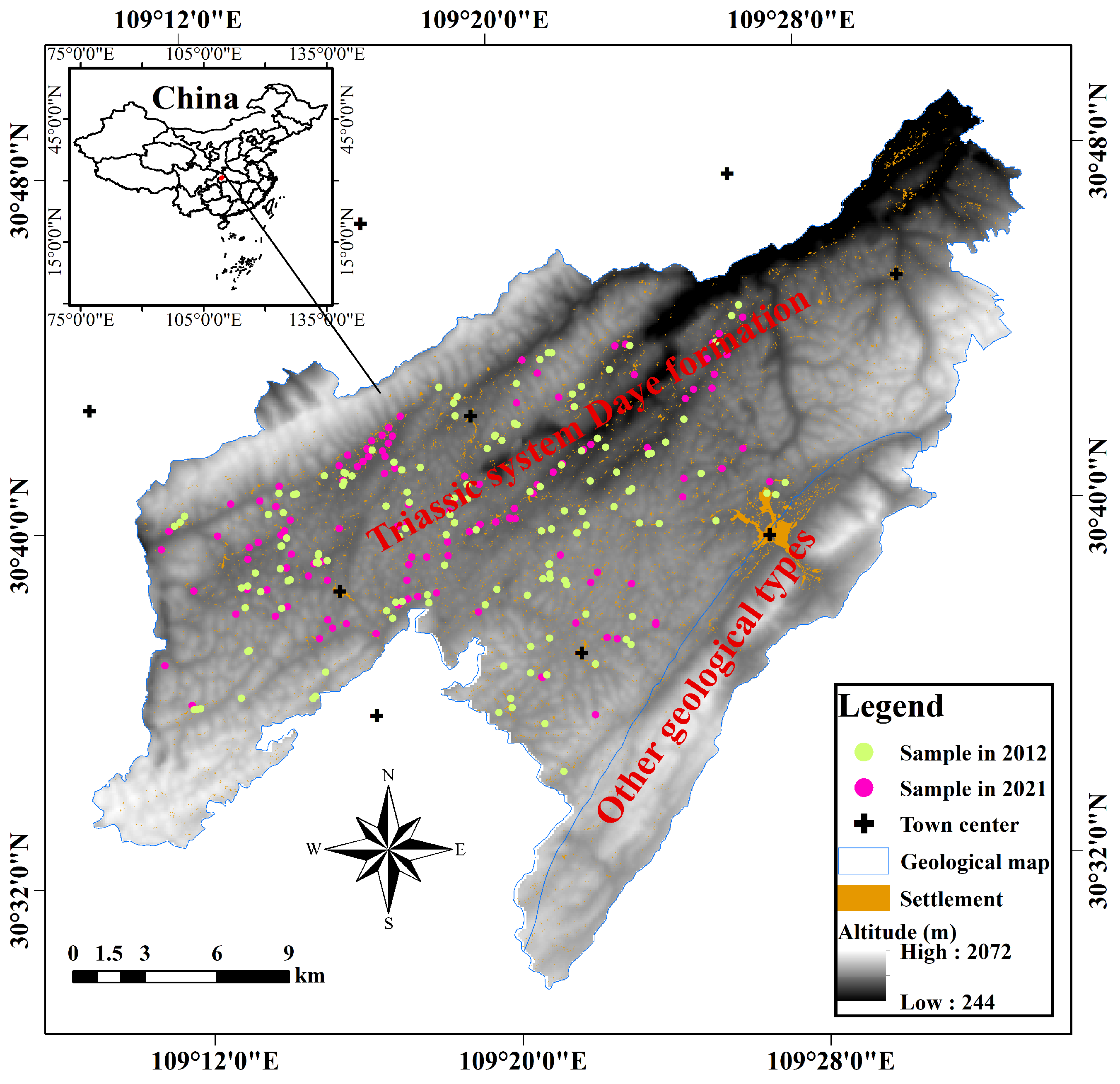
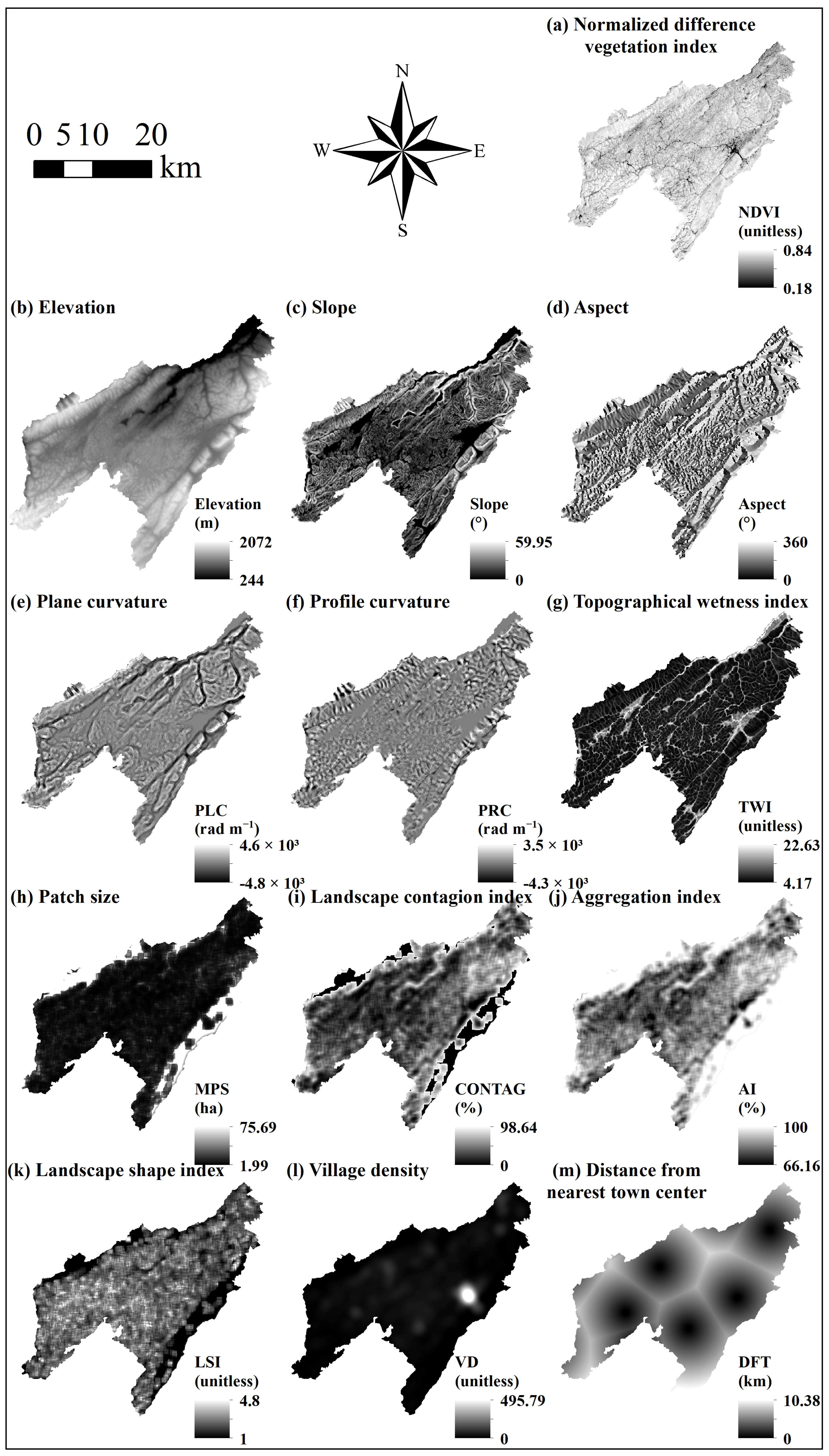
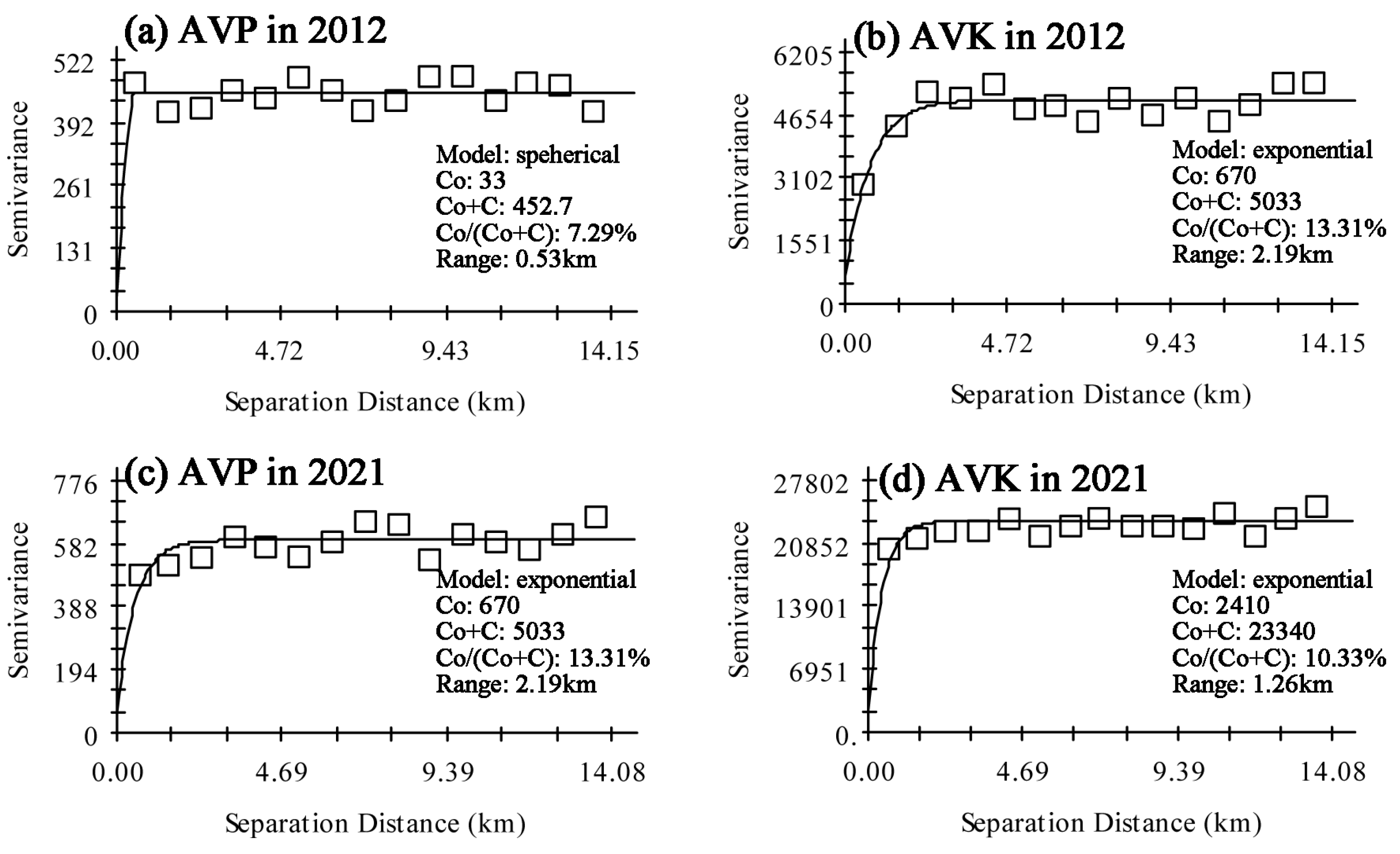
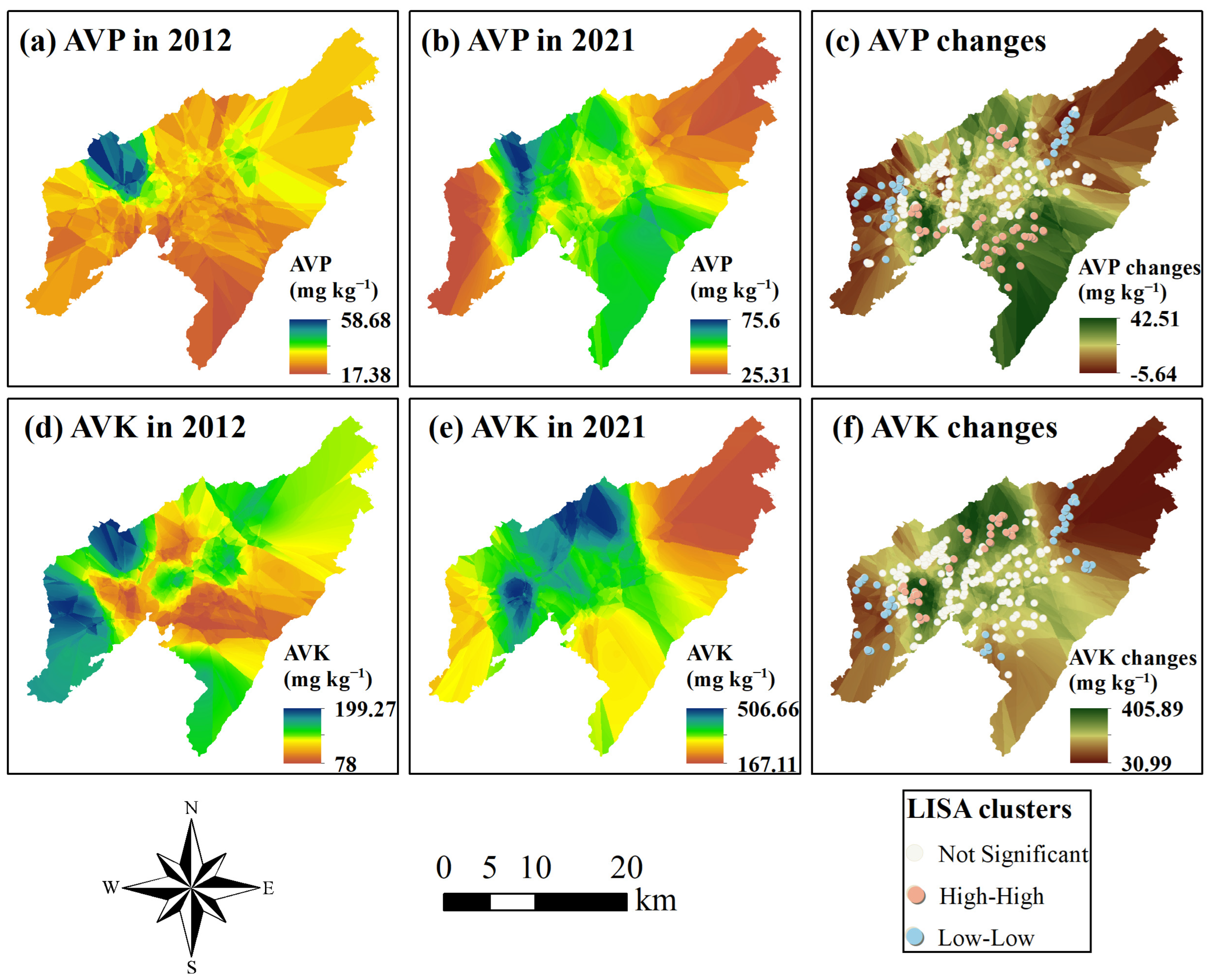

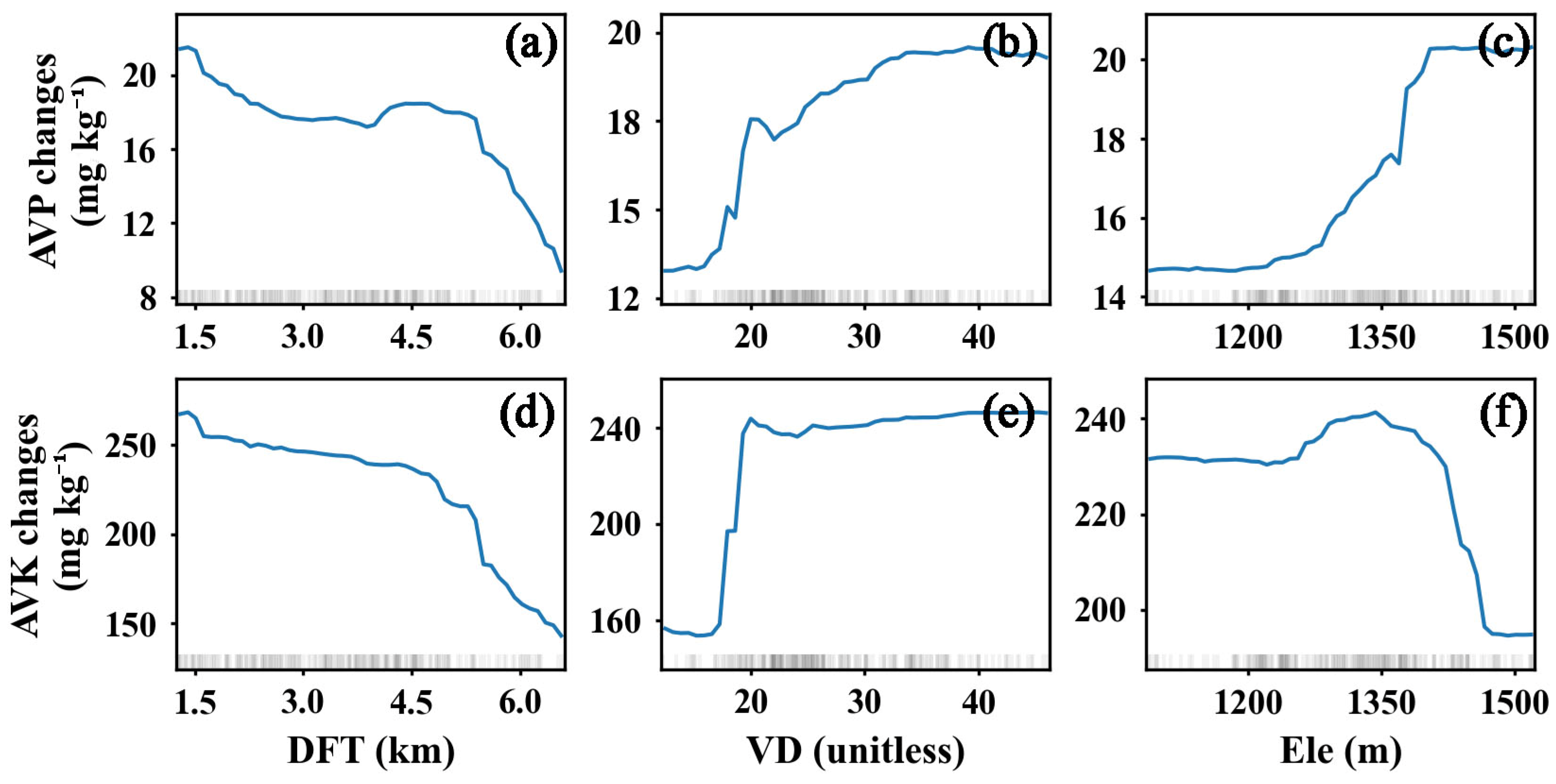

| Type | Variables | Abbreviation | Unit | Data Source |
|---|---|---|---|---|
| Biology | Normalized difference vegetation index | NDVI | unitless | Google Earth Engine platform |
| Topography | Elevation | Ele | m | ASTER GDEM v3 |
| Slope | Slp | ° | ||
| Aspect | Asp | ° | ||
| Plane curvature | PLC | rad m−1 | ||
| Profile curvature | PRC | rad m−1 | ||
| Topographical wetness index | TWI | unitless | ||
| Landscape pattern | Patch size | MPS | ha | Land use map, Chongqing Provincial Department of Land and Resources |
| Landscape contagion index | CONTAG | % | ||
| Aggregation index | AI | % | ||
| Landscape shape index | LSI | unitless | ||
| Socio-geographical factors | Village density | VD | unitless | Land use map and Google Earth Pro platform |
| Distance from the nearest town center | DFT | km |
| Item | Abbreviation | Unit | Minimum | Maximum | Median | Mean | SD | CV (%) | Skewness |
|---|---|---|---|---|---|---|---|---|---|
| AVP in 2012 | AVP2012 | mg kg−1 | 0.68 | 110.15 | 23.61 | 28.84 | 21.11 | 73.18 | 1.28 |
| AVP in 2021 | AVP2021 | mg kg−1 | 4.70 | 130.40 | 45.15 | 48.25 | 24.76 | 51.32 | 0.79 |
| AVK in 2012 | AVK2012 | mg kg−1 | 32.12 | 371.44 | 117.5 | 131.67 | 70.46 | 53.51 | 1.12 |
| AVK in 2021 | AVK2021 | mg kg−1 | 97.54 | 782.79 | 332.01 | 357.34 | 155.26 | 43.45 | 0.68 |
| Normalized difference vegetation index | NDVI | unitless | 0.35 | 0.80 | 0.66 | 0.65 | 0.07 | 10.74 | −0.79 |
| Elevation | Ele | m | 1000 | 1667 | 1324 | 1314.11 | 134.06 | 10.20 | −0.18 |
| Slope | Slp | ° | 0.00 | 51.28 | 4.75 | 7.55 | 9.72 | 128.78 | 1.87 |
| Aspect | Asp | ° | 0.01 | 360 | 145.49 | 169.92 | 107.61 | 63.33 | 0.25 |
| Plane curvature | PLC | rad m−1 | −7 × 10−3 | 5.1 × 10−3 | −9 × 10−7 | −2 × 10−4 | 1.7 × 10−3 | / | −0.76 |
| Profile curvature | PRC | rad m−1 | −1.17 × 10−2 | 4.7 × 10−3 | −1.17 × 10−3 | −1.4 × 10−3 | 2.2 × 10−3 | / | −0.99 |
| Topographical wetness index | TWI | unitless | 3.65 | 21.97 | 9.57 | 10.20 | 4.41 | 43.20 | 0.66 |
| Aggregation index | AI | % | 70.41 | 100 | 81.78 | 81.81 | 4.09 | 4.99 | −0.23 |
| Landscape contagion index | CONTAG | % | 0.00 | 57.61 | 25.30 | 25.32 | 9.45 | 37.33 | 0.56 |
| Landscape shape index | LSI | unitless | 1.00 | 2.49 | 1.70 | 1.73 | 0.22 | 12.48 | 0.86 |
| Patch size | MPS | ha | 3.15 | 75.69 | 5.82 | 6.65 | 4.82 | 72.53 | 1.36 |
| Distance the from nearest town center | DFT | km | 0.65 | 7.77 | 4.97 | 3.65 | 1.59 | 43.5 | 0.32 |
| Village density | VD | unitless | 4.58 | 228.75 | 25.39 | 29.44 | 21.38 | 72.61 | 6.77 |
| Item | Metrics | Model-A | Model-B | Model-C | Model-D | Model-E |
|---|---|---|---|---|---|---|
| AVP changes | R2 | 0.14 ± 0.14 | 0.17 ± 0.13 | 0.33 ± 0.16 | 0.36 ± 0.13 | 0.41 ± 0.14 |
| (mg kg−1) | RMSE | 8.50 ± 0.77 | 8.39 ± 0.75 | 7.51 ± 0.86 | 7.34 ± 0.77 | 7.11 ± 0.79 |
| AVK changes | R2 | 0.15 ± 0.12 | 0.16 ± 0.10 | 0.42 ± 0.12 | 0.40 ± 0.11 | 0.44 ± 0.13 |
| (mg kg−1) | RMSE | 71.21 ± 6.57 | 69.88 ± 6.64 | 58.01 ± 6.48 | 58.91 ± 6.69 | 56.89 ± 6.57 |
Disclaimer/Publisher’s Note: The statements, opinions and data contained in all publications are solely those of the individual author(s) and contributor(s) and not of MDPI and/or the editor(s). MDPI and/or the editor(s) disclaim responsibility for any injury to people or property resulting from any ideas, methods, instructions or products referred to in the content. |
© 2024 by the authors. Licensee MDPI, Basel, Switzerland. This article is an open access article distributed under the terms and conditions of the Creative Commons Attribution (CC BY) license (https://creativecommons.org/licenses/by/4.0/).
Share and Cite
Zhang, W.; Zhang, Y.; Zhang, X.; Wu, W.; Liu, H. The Spatiotemporal Variability of Soil Available Phosphorus and Potassium in Karst Region: The Crucial Role of Socio-Geographical Factors. Land 2024, 13, 882. https://doi.org/10.3390/land13060882
Zhang W, Zhang Y, Zhang X, Wu W, Liu H. The Spatiotemporal Variability of Soil Available Phosphorus and Potassium in Karst Region: The Crucial Role of Socio-Geographical Factors. Land. 2024; 13(6):882. https://doi.org/10.3390/land13060882
Chicago/Turabian StyleZhang, Weichun, Yunyi Zhang, Xin Zhang, Wei Wu, and Hongbin Liu. 2024. "The Spatiotemporal Variability of Soil Available Phosphorus and Potassium in Karst Region: The Crucial Role of Socio-Geographical Factors" Land 13, no. 6: 882. https://doi.org/10.3390/land13060882
APA StyleZhang, W., Zhang, Y., Zhang, X., Wu, W., & Liu, H. (2024). The Spatiotemporal Variability of Soil Available Phosphorus and Potassium in Karst Region: The Crucial Role of Socio-Geographical Factors. Land, 13(6), 882. https://doi.org/10.3390/land13060882





